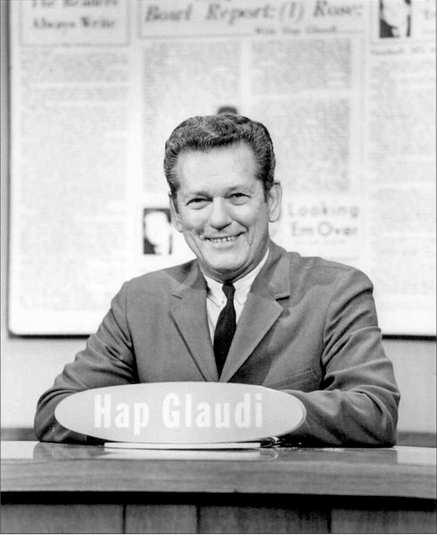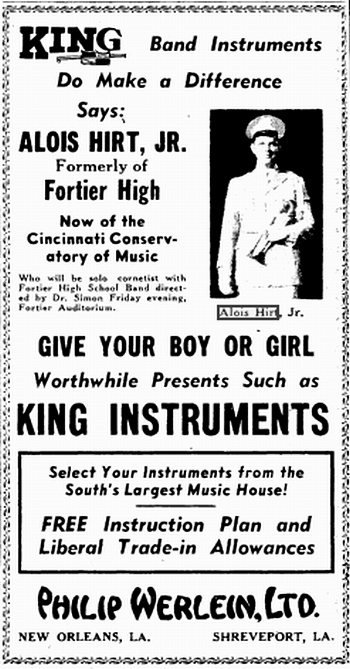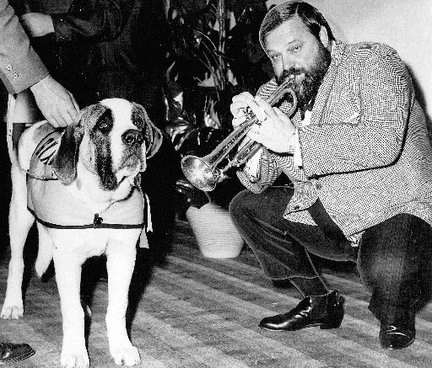|
Today in New Orleans History |
|
|
November 7


Happy Birthday Hap Glaudi Born in New Orleans on November 7, 1912 and a lifelong resident, Lloyd
Alfred "Hap" Glaudi attended Jesuit where he first picked up the nickname "Hap"
because of his jovial demeanor. Local broadcaster Ron Brocato reported that Glaudi financed his high school education through
winnings at the Fair Grounds -- long-shot bets suggested to him by a bookie. A graudate of Loyola, Glaudi's first professional job was for the New Orleans Item newspaper. During
his 25 years with the Item, he became feature sportswriter for high school
sports. He publicly prodded predominately white Jesuit High School and then predominately
African-American St. Augustine High School to play each other in high school basketball in 1965, which is credited
by some to have ended the local racial divide in high school sports. A Hap Glaudi Scholarship is now offered by his alma
mater. Hap and his wife Millie had three daughters. He passed
away on December 29, 1989 at the age of 77. (Wiki)
The 2011–12 NCAA Division I men's basketball season began on November 7, 2011
with the (2K Sports Classic) and ended with the 2012 NCAA Men's Division I Basketball Tournament's championship game on April
2, 2012 at the Mercedes-Benz Superdome in New Orleans. The tournament began with four first-round games on March 13–14,
2012 in Dayton, Ohio, US, followed by second and third rounds on Thursday through Sunday, March 15–18, 2012. Regionals
games were played on Thursday through Sunday, March 22–25, 2012, with the Final Four
played on Saturday and Monday, March 31 and April 2, 2012. Kentucky claimed its eighth NCAA title, defeating Kansas
67–59 in the final. Consensus national player of the year Anthony Davis of Kentucky was named Most Outstanding Player
of the tournament.
Stan Rice (November 7, 1942 – December 9, 2002), was a Professor of English
and Creative Writing at San Francisco State University. In 1977 he received the Academy of American Poets' Edgar Allan Poe
Award for Whiteboy, and in subsequent years was also the recipient of the Joseph Henry Jackson Award
as well as a writing fellowship from the National Endowment for the Arts.Rice retired after 22 years as Chairman of the Creative Writing program as well as Assistant Director of the Poetry Center in 1989. It was
the death of he and his wife, Anne Rice's daughter Michele (1966–1972), at age six of leukemia, which sparked Stan Rice's
becoming a published author. His first book of poems, based on his daughter's illness and death, was titled Some Lamb,
and was published in 1975. He encouraged his wife to quit her work as a waitress, cook and theater usher in order to devote
herself full-time to her writing, who both eventually encouraged their son, novelist Christopher Rice, to become a published
author as well. Rice, Anne, and son Christopher moved to Garden District, New Orleans in 1988, where he eventually opened
the Stan Rice Gallery.
Born in New Orleans on November 7, 1922, Alois Maxwell Hirt, son of NOPD officer
Alois Sr. and Linda Goupe, grew up at 1643 Mandeville Street. He began earning musical awards for his trumpeting acumen
while a student at Jesuit and Fortier. He played in the Junior Police Band with the children of Alcide Nunez,
and by the age of 16, was playing professionally, often with his friend Pete Fountain. During this time, he was
hired to play at the Fair Grounds, beginning a six-decade connection to horse racing. In 1940,
he studied at the Cincinnati Conservatory of Music with Dr. Frank Simon (a former soloist with the John
Philip Sousa Orchestra). Hirt is pictured on the right at age 18 in an advertisement for Werlein's on December 18,
1940. After a stint as a bugler in the United States Army during World
War II, Hirt performed with various Swing big bands, including those of Tommy Dorsey,
Jimmy Dorsey, Benny Goodman, and Ina Ray Hutton. In 1950, he became first trumpet and
soloist with Horace Heidt's Orchestra. Upon his return to New Orleans, he worked with
various Dixieland groups and lead his own bands including Al Hirt's Dixieland Band -- of which Pete Fountain
was a member until taking a job in the late 1950s to be on the cast of the Lawrence Welk Show. During the early 50s, he was
on staff as the orchestra leader for WWL. During the 50s and 60s he was a regular at Pier 600 on Bourbon at St. Louis Street.
In 1962 Hirt opened his own club on Bourbon Street in the French Quarter, which he ran until 1983.
His fame was growing and he was sometimes called "Gabriel of the South". In 1958 he
and Fountain appeared together on the Lawrence Welk show. On August 12, 1960, Al Hirt and his Swingin' Dixie's
were featured at Jazz Fest. On February 26, 1961 he and his band played on the Dinah Shore Show. He
was now being called "King of Trumpets". Twenty two of his albums were on the Billboard
charts in the 1950s and 1960s. The albums Honey In The Horn and Cotton Candy were both in the Top
10 best sellers for 1964, the same year Hirt scored a hit single with his cover of Allen Toussaint's
"Java" (Billboard No. 4), and later won a Grammy Award for the same recording. Both Honey in the
Horn and "Java" sold over one million copies, and were awarded gold discs. He recorded the theme for
the 1960s TV show "The Green Hornet", which re-gained public attention in 2003 when it was used in
the film Kill Bill. In 1967 Hirt became one of 18 minority owners (Hirt had
2.5%) of our brand new NFL expansion team, the New Orleans Saints. He is pictured (left) on September
12 1967 playing to Gumbo, the Saints' mascot, at a Jung Hotel luncheon for coaches and players before the kickoff
of the first season. Gumbo had been a gift to the team by the Louisiana Restaurant Association. Hirt was the musical
director for the Saints and played the National Anthem at the first season game, five days later on on September 17.
Hirt became a fixture at Saints games,playing his horn for fans as often as possible. Gumbo's descendant, Gumbo IV was fired
in November 1985, now replaced by a human dressed in a St. Bernard costume. The photograph is by J.W. Guillot/Times-Picayune
archives. On February 7, 1970, while riding in the Bacchus parade, he
was struck by a hurled brick, rock, or cement chunk (sources vary) which left him bleeding profusely and the needing 12 (or
16, sources vary) stitches across the entire underside of his upper lip. He was taken from the float, rushed to Baptist Hospital,
treated, and then attended the krewe's ball at the Rivergate the same evening. He was forced to cancel two upcoming
performing commitments and await the healing process to know if he would ever be able to play the trumpet again as he did
in the past. His career was seriously threatened and the public was outraged, calling for the end this sort of violence
that had occured at many other parades during that Carnival season. The story made national news. This incident was
parodied in a Saturday Night Live skit from their second season Mardi Gras special, the "Let's Hit Al Hirt
in the Mouth with a Brick Contest" |
|
|

To receive an update for each day in New Orleans history,
join our facebook page - Today in New
Orleans History.
Analytics |




 "Jumbo" and Gumbo
"Jumbo" and Gumbo
